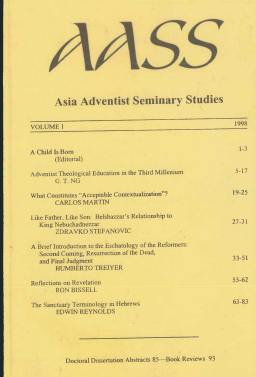The Sanctuary Terminology in Hebrews
Abstract
As one reads various translations of chaps. 8-10 of the Epistle to the Hebrews, one is struck with the diversity of the translations that are used for the Greek term . . . . and its variant forms with reference to the sanctuary. Either there is a lot of uncertainty about what the term means, or it is simply being translated to suit particular theological views. We prefer to assume the former.
A 1967 study by A. P. Salom used a broad statistical study of . . . . in the LXX as a basis for determining the meaning of . . . . in Hebrews. Whether or not one agrees with his conclusions, his methodology seems to be problematic. When one evaluates the context of each use and discovers that the majority have nothing to do with the sanctuary per se or its apartments, he or she realizes that the statistics themselves prove nothing for the book of Hebrews, and a different approach needs to be taken to produce a more viable result.
A very brief 1981 study by Norman H. Young also failed to produce a fully satisfactory result, since he did not take into account any evidence outside of the book of Hebrews to see how the term would have been understood by the readers of the book based on the terminology commonly used during that period.
The purpose of this article is to explore anew the literature that may shed light on the use and meaning of . . . . and related terms for the sanctuary used in the Epistle to the Hebrews. Specifically, I study the sanctuary terminology used in the LXX and the writings of Philo and Josephus, in the hope that we may with more certainty be able to translate the terms in Heb 8-10 correctly. In order to do this better than the previous studies, a more careful and consistent methodology must be used. Rather than considering every use of the term . . . . irrespective of its context and uses, as Salom did, we will consider only those passages that refer specifically to the sanctuary itself or its apartments. In the LXX, I have chosen to focus on the sections of Exodus and Leviticus which discuss the establishment of the wilderness tabernacle, reflecting the earliest terminology for the sanctuary and forming a significant theological background for the Epistle to the Hebrews. In addition, I consider also the passages in Kings and Chronicles which deal with Solomon's temple and reflect the terminology of the Second Temple period. Special attention is also given to those passages in Philo and Josephus that discuss the sanctuary/temple, since they were written in the first century A.D., very close to the time the Epistle to the Hebrews was written, and therefore would be expected to use a similar terminology.
Once I have reviewed the pertinent literature and drawn conclusions, then I do a brief exegesis of the relevant passages in Heb 8-10 to determine how this meaning suits the local context and whether or not the conclusions aid in interpreting the text.
The goal of this study is to contribute to a better understanding of the work of Christ in the heavenly sanctuary by providing a more careful methodology for understanding the meaning of the sanctuary terminology in Hebrews.

